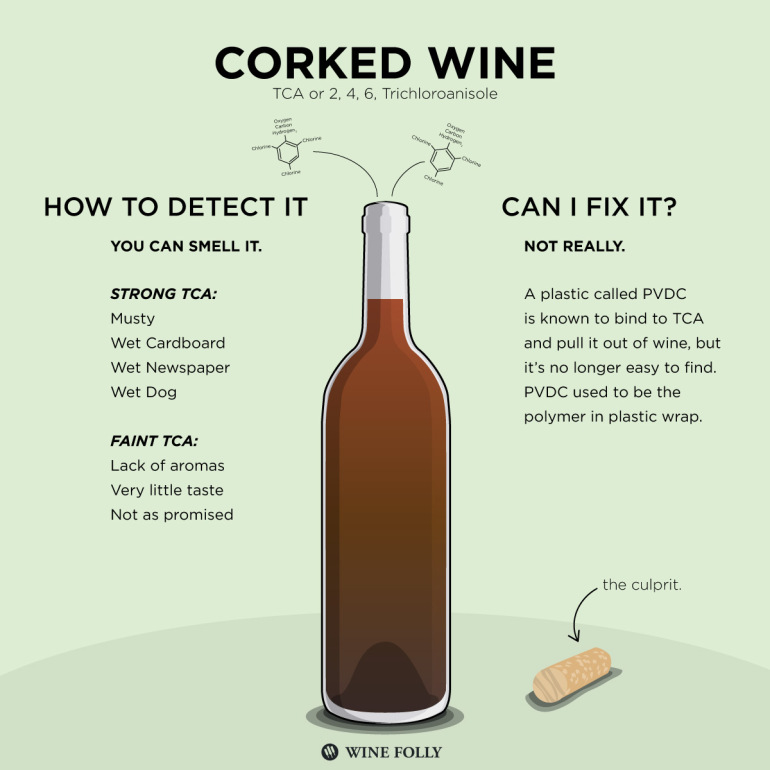Corked wine is so off-putting that some people will swear off wine after their first bad experience. But… how do you tell if a wine is corked?
Cork taint isn’t easily identified which can make it hard to differentiate bad wine from wine that’s gone bad… Below we’ll cover: How often is wine corked? What causes it? What can we do about it?
A typical wine consumer will encounter ~100 corked bottles in their lifetime.
About 2-3% of wine is corked. Outrageous.

Corked Wine Clues
Known in the business as TCA and to chemists as 2, 4, 6, Trichloroanisole, cork taint effects about 2-3% of bottled wines (or about a bottle in every 2 cases). This number sounds low, but if you drink wine regularly, you’ll encounter a corked bottle about 100 times in your adult life which, believe me, starts to really suck.
You can return corked wines, but not always. On one occasion, I traveled to Los Angeles with a fancy bottle of Amarone della Valpolicella. I’d assured my friends that the wine ‘would change their life’. I wasn’t exactly wrong, because they had never sniffed a corked wine. Still, throwing money out a window would have been more gratifying. (proof)
Is corked wine safe to drink?
Yes. Cork taint isn’t bad for you; it just really dampens the mood.
What does a Corked Wine Smell Like?
Profile of a corked wine with high levels of TCA:
- Musty
- Wet Dog
- Wet Cardboard
- Wet Newspaper
- Grandma’s Basement
Take a washcloth, make it wet and wipe your armpits. Wring it out, but don’t completely dry it. Put it in a plastic container with a lid and leave it overnight. Congratulations! In the morning you’ll have a musty towel to smell.
By the way, when a wine has low levels of TCA it might not stink of the aforementioned aromas. Instead, it will just have no fruit and floral smells and very little flavor. You might think the wine was just boring. Review the checklist below to confirm TCA as the culprit:
Cork Taint (TCA) Checklist
- The wine has a real cork. (alternatives to corks)
- Does the wine have accolades and reviews that don’t line up with what’s in your glass?
- Is your palate acting up again? (drink some water, smell your forearm and re-sniff)
- Does your drinking buddy think it’s corked too?
Learning how to identify the corked flavor in wine takes a little practice. If your sommelier tries to take the corked bottle away, ask her to leave you a splash so you can learn too. She will think you’re weird, but remember, you’re the one with the credit card.
Handling Corked Wine
If you are buying wine in a restaurant you can simply send it back. If you ordered the wine online, save your receipts. Many online retailers will happily refund you or send you a fresh bottle.
Does Saran Wrap Really Fix a Corked Wine?
Perhaps you’ve heard of the Saran Wrap trick? After the ‘Amarone Incident’ mentioned above, I did a little research. As luck would have it, Dr. Andrew Waterhouse from UC Davis found that the plastic molecules in Saran Wrap cling to the TCA molecules and ‘pull’ them out of wine. Unfortunately, it doesn’t work anymore.
Unfortunately, the Saran Wrap wine trick doesn’t work like it used to.

Saran Wrap changed their plastic wrap formula in 2004. This was a smart choice because the original formula might have been leaching chlorine into food. The original Saran was developed in 1933 and used a polymer called PVDC (polyvinylidene chloride). PVDC is still used today in commercial food applications (think: ‘frozen turkey wrap’) as well as in commercial winery operations to remove cork spoilage.
Where Does TCA Really Come From?
TCA is stranger than you might think. It happens when little airborne fungi and bacteria come in contact with chlorine and phenolic compounds at the same time. As it happens, wineries are in the business of making phenolic compounds and many wineries used to clean their equipment with chlorine solutions. While this practice is now known as a big no-no, it’s hard to get rid of TCA once it happens.
The most common way that TCA gets into wine is from corks. In this situation, the TCA is from fungus reacting to a common plant fungicide that contains… guess what, chlorine!
Now that you know how reactive chlorine can be in the presence of wine, you might want to stop cleaning your house with it. Just sayin’.

